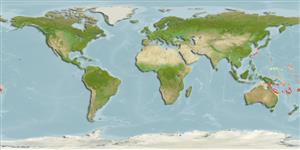Classification / Names
Nomi Comuni | Sinonimi | Catalog of Fishes(Genere, Specie) | ITIS | CoL | WoRMS | Cloffa
>
Perciformes/Scorpaenoidei (Scorpionfishes) >
Scorpaenidae (Scorpionfishes or rockfishes) > Scorpaeninae
Etymology: Scorpaenopsis: Latin, scorpaena = a kind of fish, 1706 + Greek, opsis = appearance (Ref. 45335); eschmeyeri: Named for William N. Eschmeyer, in recognition of his research on the Scorpaenidae..
More on authors: Randall & Greenfield.
Environment: milieu / climate zone / depth range / distribution range
Ecologia
marino demersale; distribuzione batimetrica 1 - 24 m (Ref. 57579). Subtropical
Southwestern Pacific: Fiji and New Caledonia.
Size / Peso / Age
Maturity: Lm ? range ? - ? cm
Max length : 7.6 cm SL maschio/sesso non determinato; (Ref. 57579); 11.5 cm SL (female)
Short description
Morfologia | Morfometria
Spine dorsali (totale): 12; Raggi dorsali molli (totale): 9; Spine anali 3; Raggi anali molli: 5. Diagnosis: Dorsal rays XII,9; anal rays III,5; pectoral rays 17-18 (rarely 18). Longitudinal scale series 44--48 (modally 46). Body depth 2.8-3.05 in SL; head length (HL) 2.2-2.3 in SL; snout length 3.0-3.15 in HL; orbit diameter 4.65--4.95 in HL; nearly one-half of orbit extending above dorsal profile of head; interorbital width 6.75-7.2 in HL. Pair of interorbital ridges flaring posteriorly, then curving medially to join slight incurved ridge at front of occipital pit; median interorbital ridge extending half way back in interorbital space; occipital pit shallow and not flat. Coronal spines and pretympanic spines absent. Suborbital pit not well developed; suborbital ridge with 4 spines, the first on lacrimal; two ventral spines on lacrimal, one directed mainly anteriorly and the other curving posteriorly. First dorsal spine 1.9-2.4 in second spine; third dorsal spine longest, 2.2-2.7 in HL; eleventh dorsal spine 1.55-2.0 in twelfth spine; second anal spine 1.65-2.0 in HL. Supraoccipital tentacle absent. Body color variable, the darkest blotches usually above tip of upper opercular spine, two on lateral line, two obliquely above and forward of these, two in soft portion of dorsal fin, and one in anal fin (Ref. 57579).
Inhabits coral reef. Benthic (Ref. 75154).
Life cycle and mating behavior
Maturità | Riproduzione | Deposizione | Uova | Fecundity | Larve
Randall, J.E. and D.W. Greenfield, 2004. Two new scorpionfishes (Scorpaenidae) from the South Pacific. Proc. Calif. Acad. Sci. 55(9):384-394. (Ref. 57579)
IUCN Red List Status (Ref. 130435)
Threat to humans
Venomous
Human uses
Informazioni ulteriori
Nomi ComuniSinonimiMetabolismoPredatoriEcotossicologiaRiproduzioneMaturitàDeposizioneSpawning aggregationFecundityUovaEgg development
Age/SizeAccrescimentoLength-weightLength-lengthLength-frequenciesMorfometriaMorfologiaLarveDinamica popolazioni larvaliReclutamentoAbbondanzaBRUVS
BibliografiaAcquacolturaProfilo di acquacolturaVarietàGeneticaElectrophoresesEreditarietàMalattieElaborazioneNutrientsMass conversion
CollaboratoriImmaginiStamps, Coins Misc.SuoniCiguateraVelocitàModalità di nuotoArea branchialeOtolithsCervelliVista
Strumenti
Special reports
Download XML
Fonti Internet
Estimates based on models
Preferred temperature (Ref.
123201): 24.7 - 27.9, mean 26.5 °C (based on 307 cells).
Phylogenetic diversity index (Ref.
82804): PD
50 = 0.5000 [Uniqueness, from 0.5 = low to 2.0 = high].
Bayesian length-weight: a=0.01259 (0.00606 - 0.02615), b=3.03 (2.86 - 3.20), in cm total length, based on LWR estimates for this (Sub)family-body shape (Ref.
93245).
Trophic level (Ref.
69278): 3.9 ±0.7 se; based on size and trophs of closest relatives
Resilienza (Ref.
120179): Medio, tempo minimo di raddoppiamento della popolazione 1.4 - 4.4 anni (Preliminary K or Fecundity.).
Fishing Vulnerability (Ref.
59153): Low vulnerability (10 of 100).
